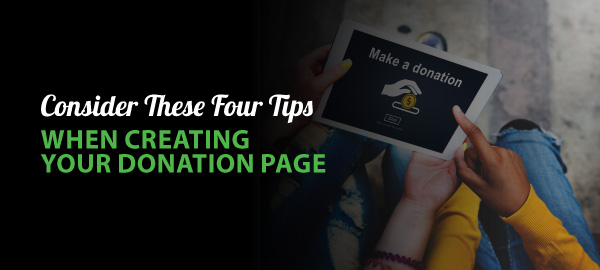
Picture this: your nonprofit team makes a compelling fundraising appeal that leads a potential donor to your organization’s website in search of your donation page. Unfortunately, then they’re met with a donation form that’s convoluted and unintuitive. The process either takes too long or they’re unable to figure out how to give. You lose a potential donor.
Don’t let this donor journey happen to your constituents. Instead, with a few key tips on how to optimize your donation form for the best user experience possible, you’ll be all set for success. At iATS Payments, we’ve seen how implementing best practices into creating your donation page and form can make the difference between reaching your fundraising goals and losing out on donations.
Here are a few essential tips on how to design the best donation page on your nonprofit’s website:
- Make your form accessible to all
- Offer suggested donation amounts
- Determine your essential questions
- Use a secure payment processor
Let’s dive in and learn how to improve your user experience for your donors when they give to your organization online.
Make your form accessible to all
To host the most efficient donation page on your nonprofit website, make sure your donation form is accessible to all donors. This can include taking measures and implementing donation form best practices for all types of devices and making sure it seamlessly integrates with your site.
To start, let’s unpack a few of the most common ways to make your donation form accessible to users on your website:
- Make sure you embed your donation form on an easily navigable area of your website. If your donors are giving to your organization after seeing your social media or email pushes, it’s likely they will be directed to your website to give. Your nonprofit’s site acts as a central hub for your digital fundraising, so make sure it’s easy to do so. A good practice when designing your site is to include a link to your donation page on the header or in a side pop-up on every page. Once they reach your donation page, be sure to embed your form directly on top of your online donation page for easy use.
- Optimize your donation page and form for multiple browsers. When you design your donation form to be responsive on all browsers and screen sizes, your form can be completed by a broader audience. It’s recommended to test your donation page’s format on as many screen sizes and browsers as possible for the best results.
- Format your donation form to the rest of your organization’s branding. Be sure your donation form is designed with your branding in mind. This small but effective step will help establish trust with your donors and make them feel more comfortable about giving through your site. You can do this by using your typical fonts, colors, and imagery. Cohesive designs can enhance brand recognition for your organization overall.
- Use a payment processor that keeps donors on your site. Don’t direct your users to an offsite third-party payment system. Doing this can deter potential donors simply because they feel the process is insecure. According to this donation form guide by iATS Payments, redirecting them away from your site can easily cause mistrust in your organization.
Your team’s goal should be to make your donation journey as simple as possible once they arrive on your page. Look into even more ways to make your page as accessible as possible for those who want to push your mission forward.
Offer suggested donation amounts.
Did you know that when you include donation amounts, people are more likely to give a bit more simply because they’re encouraged to do so? Once your donors fill out their information on your site’s donation form, be sure to include suggested donation amounts as a part of your questionnaire.
This way, your giving process is that much more straightforward for users. Instead of pondering the “correct” amount to donate, your users just have to click one of a few options and continue on their way. For example, you can include multiple options for amounts, depending on your needs, such as $50, $100, or $150.
When potential donors are given various donation amounts to choose from, it eliminates the uncomfortable stress of guessing how much is appropriate and what others are giving. You can determine these numbers by:
- Increasing or decreasing the amounts and determining if they affect the amount given over a few months (A/B testing).
- Adopting software that can determine these amounts for you.
- Looking at your fundraising income trends.
By tailoring your recommendations for donation amounts, you simplify the giving process and gently encourage your donors to give more. If you’re stuck on determining which amounts you want to include, be sure to check out this guide for more information.
Determine your essential questions
You’ll want to ask essential questions to collect donor data for future use on your donation form. Finding which questions to ask donors on your donation form is a balancing act. If you have too few questions, you won’t retain essential information about your donors to build donor profiles in your CRM or for future outreach. If you have too many questions, you may scare some donors away because they don’t want to sit and fill out your lengthy form.
When determining which questions to ask, look to these examples of what to ask on your form that can provide actionable insights:
- How were you motivated to give? It’s crucial to figure out which outreach methods are most effective for directing donors to your page. Ask if they were motivated to give due to direct mail, email, social media, and more. With this data, you’ll know what’s working and what’s not in your promotional efforts.
- How would you like to get further involved? Be sure to include a question regarding how your constituents want to be involved with your organization in the future. After all, they’ve already given money, so find out if they’d like to volunteer or share the word on their social media.
- Are you interested in becoming a recurring donor? Taking stock of who is giving often and in what amounts can indicate which donors are likely to be long-term support for your mission. By analyzing your donor information, you can see patterns in your donations.
The information you ask of your donors can assist with determining trends and refining your organization’s strategies going forward. Be sure to find a balance so that giving is a quick process that allows you to retain the information you need.
Use a secure payment processor
Finally, understand how to establish donors’ trust with a dedicated nonprofit payment processor. As mentioned earlier, leading donors to a third-party processor can deplete their trust and may change their minds about giving.
When you embed your payment tool on your site, look for one that will ensure the security of you and your donors. When giving to your cause, constituents input data like their names, addresses, financial card numbers, and other personal information. Look for the following features when embedding a payment tool onto your donation page:
- Active fraud protection. When choosing a payment processor, look to ones that give your team the ability to customize your security features such as fraud alerts, and suspicious transaction amounts based on you and your donors’ needs.
- Payment verification. Your payment software company needs to provide a service that alerts donors and organizations to any potentially fraudulent transactions and activity. When looking into your payment tool, ensure that you’re able to run address verification on debit and credit cards as well as inordinately large and small transactions.
- Payment Card Industry compliance. Payment Card Industry (PCI) Data Security Standard (DSS) is a set of security guidelines created by credit card companies to keep those who pay with their cards safe when participating in online transactions. Be sure you adopt a payment processor that follows these standards.
According to iATS Payments guide to payment processors, poor security can ruin your organization’s reputation forever, and harm your progress in impacting your mission.
When you keep these four tips in mind for your donation page and form, you’re sure to significantly decrease the chances that a donor will abandon their gift due to their user experience. Be sure to double-check that your page is accessible to all, and happy fundraising!
Author: Peggah Azarvash
Peggah is a passionate Sales Executive with 10 years’ experience providing payment solution support and guidance to nonprofits.
